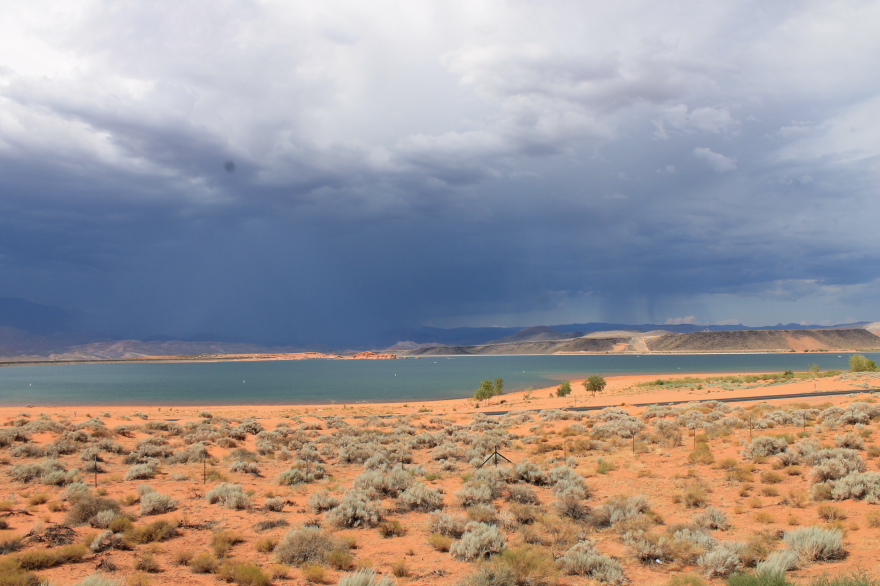In a parched corner of the nation's second driest state, the Virgin River delivers life-giving water to wildlife, farms and increasing numbers of people.
Ron Thompson sees a future when four times as many people could be living here in St. George, and they’ll need more water than the Virgin can provide. That’s why he wants the Lake Powell Pipeline.
“I think we'll hit that limit in about a decade,” says Thompson, general manager of the Washington County Water Conservancy District. “We will have developed everything we can, and unless we bring a project similar to Lake Powell online, we're really out of water in this basin. Either people gotta start bringing their water with ‘em or stay away.”
Water is the only limiting factor to the growth in Utah - Utah Gov. Gary Herbert
The pipeline would be a giant straw, nearly 6 feet in diameter and winding halfway across the state with enough water to support thousands of families in Washington and Kane counties. It also would help the state capture water promised under the 1922 Colorado River Compact – water some consider Utah’s birthright.
The state officially became the project’s leader in 2006, when lawmakers passed the Lake Powell Pipeline Development Act. Since then, the Utah Division of Water Resources has spent roughly $25 million of statewide sales tax revenues on the application to license the project through the Federal Energy Regulatory Commission. The application is due in a year.
Thompson says Utahns see the pipeline as an economic investment. It’s also a means of fulfilling the state’s and the region’s destiny.
“The question really is: Does Utah, who has a big water right that comes into Lake Powell every year, can only get out of Lake Powell, do they allow that water to stay here so it sustains our economy and we use our water here?” Thompson asks, “or do we allow it to go downstream to support and sustain other economies and other citizens that doesn't help our kids or our economy?”

Lake Powell water would be stored at Sand Hollow Reservoir if the pipeline’s built. But Jane Whalen hopes that won’t happen. She’s a founding member of the local environmental group, Citizens for Dixie's Future.
"I think there's great strides that we can make that would fill the need for water for the future,” she says, “and we should just be self-reliant on the water supplies that we have here first before we try to bring in a pipeline."
Whalen says pipeline supporters are exaggerating demand projections and underestimating conservation. And, while supporters say the pipeline will cost less than $1 billion dollars, critics like Whalen predict it will be much more expensive.

"If it's gonna be paid with impact fees and things like that and water rates, property taxes -- they're all gonna have to go up to pay for it,” she says. “So, in the long term, it's really a bad thing for our local community to take on that type of debt.”
Environmentalists have developed an alternative plan that promises enough water to keep up with growth at about one third the cost -- by reusing water, updating farm irrigation and other water-saving measures. It also calls for higher prices that reflect how valuable water is in a desert. That’s opposite of what’s happening now with St. George water rates, Whalen says.
"They're using the most water per person, and it's the cheapest water in the West,” she says. “That's what they're telling us, yes. And that's what the reports say."
Critics like Dan Beard say the practice of using property taxes help pay for water service sends customers the wrong message about using it wisely.
“If you give people something for free, they’ll waste it,” says Beard, former director of the Bureau of Reclamation, the federal agency that created Lake Powell. “If you want to promote conservation, the first thing you need to do is raise the price of water."
The West’s 15-year drought is already heating up the broad water debate, with California’s turmoil dominating the news. But water has risen to the top of Utah’s agenda too.
Utah lawmakers created a multi-million-dollar fund this winter to help plan for projects like the Lake Powell Pipeline. And Governor Gary Herbert has hinted the project will be part of the state’s water solution.
“Water is the only limiting factor to the growth in Utah,” he told reporters at the KUED monthly news conference in April.
“It’s going to be a matter of conserving what we have and also developing what we need going into the future. That’s a significant challenge. We live in an arid climate. You know, it’s a desert.”

It’s a challenge that Washington County won’t be able to avoid. Last summer dozens of farmers lost the right to irrigate their crops from Virgin River tributaries because water supplies were so tight.
It became clear that the situation hasn’t improved when water managers throughout the state met last month at Salt Lake City’s National Weather Service office. Hydrologist Brian McInerney detailed the gloomy water situation statewide and how the winter’s lean snowpack has starved the Virgin River again.
“So there you have it. There’s my info,” McInerney said. “I feel like the Grim Reaper. I just travel around giving depressing news to everybody all the time. I’m getting a complex -- as everyone else is.”
Utah’s debate about building the Lake Powell Pipeline remains contentious after more than a decade. But it’s also fueling a crucial discussion about how Utah can’t keep growing without rethinking its strategies for managing this vital resource.










